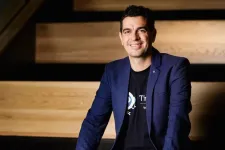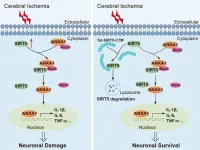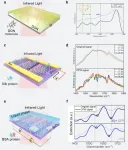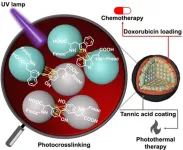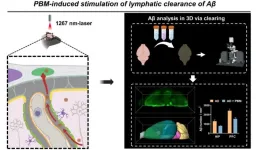(Press-News.org) Children who develop neuroblastomas, a rare form of cancer which develops in nerve cells, may benefit from receiving certain anti-tumour drugs as well as chemotherapy, a new trial has found.
The results of the BEACON trial conducted by the Cancer Research UK Clinical Trials Unit at the University of Birmingham found that combining anti-angiogenic drugs, which block tumours from forming blood vessels, alongside various chemotherapy drugs led to more young people seeing their tumours shrinking, from 18% in the control group to 26% among those on Bevacizumab.
The findings are published in the Journal of Clinical Oncology today. The trial saw 160 young people aged 1-21, from 43 hospitals in 11 European countries, randomised with half receiving the anti-angiogenic drug called Bevacizumab on top of conventional therapy. The group who received Bevacizumab had an increase in the likelihood of responding to treatment, from 18% among those who only had the established therapy to 26% for those with the additional drug. Patients who received Bevacizumab additionally had better one year progression-free survival rates.
The trial constituted one of many collaborations between the University of Birmingham and European expert groups SIOPEN (International Society of Paediatric Oncology European Neuroblastoma) and ITCC (Innovative therapies for children with cancer).
Simon Gates, Professor of Biostatistics and Cli nical Trials at the University of Birmingham and senior lead author of the paper said:
“These are very exciting results that hopefully get us closer to finding treatments for children who develop neuroblastomas. Currently, the outcomes are really poor for children who get this horrible cancer and so even seemingly small increases in the chance that a patient is going to be able to shrink their tumours is significant.
“We are delighted that the BEACON trial has helped to shape treatment for children with relapsed and refractory neuroblastoma going forward.”
Dr Lucas Moreno, Head of Pediatric Hematology and Oncology at Vall d'Hebron University Hospital, Barcelona, Spain and Chief Investigator for the study said:
“BEACON was a hypothesis-generating trial that has served to identify active regimens that are now being further investigated. We are delighted that the data generated has been incorporated into the current UK Clinical Practice Guidelines and Bevacizumab is incorporated into standard treatment for relapsed neuroblastoma.”
Dr Laura Danielson, Children and Young People’s Research Lead at Cancer Research UK who part funded the trial said: “There are limited effective treatment options available for children whose neuroblastoma has not responded or come back after initial treatment. The results from the BEACON trial provide more hope to these families by finding a drug combination that is better at treating the disease than standard chemotherapy alone.
“These incremental improvements in treatment can make all the difference for cancer patients and it’s fantastic to see that the standard of care across the UK has already been updated based on these results giving children with neuroblastoma more treatment options.
“Meanwhile, more work is still needed to achieve greater survival and long-term quality of life for children affected by neuroblastoma and this trial is helping to pave the way for studies to better understand the biology of this disease and further efforts to improve outcomes.”
Patricia Blanc, President, Imagine for Margo and Gail Jackson, CEO, Solving Kids’ Cancer UK commented:
"We're delighted to have contributed funding to the BEACON trial which has been a lifeline for children with relapsed and refractory neuroblastoma. It is incredibly encouraging to see such positive data from the study that is now impacting clinical practice."
END
Combining anti-tumor drugs with chemo may improve rare children’s cancer outcomes
2024-01-09
ELSE PRESS RELEASES FROM THIS DATE:
EBRAINS research infrastructure secures €38 million in funding for new phase of digital neuroscience
2024-01-09
The European Commission has accepted the EBRAINS 2.0 proposal submitted in response to the INFRASERV call, granting €38 million for the further development of services of the EBRAINS research infrastructure.
The European Commission has signed a grant agreement to fund EBRAINS with €38 million until 2026. Over the next three years, the infrastructure will continue to develop tools and services to widely serve research communities in neurosciences, brain medicine, and brain-inspired technologies.
EBRAINS (European Brain Research Infrastructures) is an EU co-funded collaborative research platform designed to advance neuroscience and brain ...
Train your brain to overcome tinnitus
2024-01-09
An international research team has shown that the debilitating impact of tinnitus can be effectively reduced in just weeks by a training course and sound therapy delivered via a smartphone app.
The team from Australian, New Zealand, French and Belgian universities report these findings today in Frontiers in Audiology and Otology.
It offers some hope for millions affected by tinnitus who:
have been told that there is nothing they can do about it
face long queues waiting for treatment, or
can’t afford the costs of specialist support.
The initial trial worked with 30 sufferers, of whom almost two thirds experienced a ‘clinically ...
A chemical reaction key to various industries just got greener
2024-01-09
Osaka, Japan – From alleviating your allergy symptoms to optimizing herbicide performance, alkylamines are molecules that have many uses. Unfortunately, common methods of producing alkylamines result in harmful waste byproducts. A method of synthesizing alkylamines in a sustainable yet cost-effective way has thus been highly sought after.
Now, in a study recently published in Green Chemistry, a research team led by Osaka University has found a way. The team has developed a method of alkylamine synthesis that works under mild conditions and produces ...
Spanish butterflies better at regulating their body temperature than their British cousins
2024-01-09
Butterfly populations in Catalonia in northern Spain are better than their UK counterparts at regulating their body temperature by basking in the sunshine, but rising global temperatures due to climate change may put Spanish butterflies at greater risk of extinction.
An international study, led by the University of Cambridge and the Institut de Biologia Evolutiva (IBE) in Barcelona, found that butterflies use different methods to regulate their body temperature. In Catalonia, butterflies tend to angle ...
A novel cell-penetrating peptide exerts therapeutic effects against ischemic stroke
2024-01-09
This study is led by Dr. Xing Li and Dr. Yilin Zhao (Department of Anesthesiology, Hubei Key Laboratory of Geriatric Anesthesia and Perioperative Brain Health, and Wuhan Clinical Research Center for Geriatric Anesthesia, Tongji Hospital, Tongji Medical College, Huazhong University of Science and Technology). The team's previous research found that the increase in SIRT5 in microglia induced by ischemic stroke causes annexin-A1 (ANXA1) desuccinylation, which decreases ANXA1 membrane recruitment and secretion but promotes ANXA1 nuclear translocation, resulting in the production of proinflammatory ...
Ultrasensitive molecular sensing with synthesize complex-frequencey waves
2024-01-09
Sensors are essential tools for detecting and analyzing trace molecules in a variety of fields, including environmental monitoring, food safety, and public health. However, developing sensors with high enough sensitivity to detect these tiny amounts of molecules remains a challenge.
One promising approach is surface-enhanced infrared absorption (SEIRA), which uses plasmonic nanostructures to amplify the infrared signals of molecules adsorbed on their surface. Graphene is a particularly promising material for SEIRA because of its high ...
Creating novel amino acid nanoparticles with enhanced anticancer activity
2024-01-09
Ishikawa, Japan -- Amino acids, such as tyrosine and tryptophan, are the fundamental building blocks that make up proteins. These biomolecules have different chemical groups on each end and side chain, and so, have the natural ability to form a chain through the formation of an amide (peptide) bond. However, such linkages are weak and easily degraded under physiological conditions. This is where the Fmoc-protected amino acids come into the picture.
In a new study now, a research team led by Dr. Eijiro Miyako, Associate ...
A landscape-based approach to urban heritage management: People, spatial biography, and ecosystem
2024-01-09
This article first identifies the current definition of urban heritage that includes both “old” and “young” monuments. Their protection has also shifted from solely preserving “old” values into a more holistic process to retain “old” values and manage the change in their adaptive reuse to gain “new” values, towards a more people-centered and landscape-based approach. Furthermore, a concept of ecosystem for urban planning and development is introduced, ...
Photostimulation: non-invasive and effective therapeutic approach for Alzheimer’s disease
2024-01-09
Alzheimer’s disease (AD) is an age-related neurodegenerative disorder. β-amyloid (Aβ) deposition in the brain is a crucial contributor to the pathogenesis of AD, mitigating excessive cerebral Aβ burden has been considered as a possible therapeutic strategy for AD. Meningeal lymphatic vessels (MLVs) are recently discovered structures responsible for exchanging soluble components between the cerebrospinal fluid and interstitial fluid, and have been proved to be a potential pathway of Aβ drainage.
Researchers at Huazhong University ...
Love scrambles the brain and scientists can now tell us why
2024-01-09
Love is blind, the saying goes, and thanks to a world-first Australian study, we are now a step closer to understanding why.
It is well known that romantic love changes the brain, releasing the so-called love hormone oxytocin, responsible for the euphoria we feel when falling in love.
Now, researchers from the ANU, University of Canberra and University of South Australia have measured how a part of the brain is responsible for putting our loved one on a pedestal in that first flush of romance.
In the world’s first study investigating the link between the human brain’s behavioural activation ...

